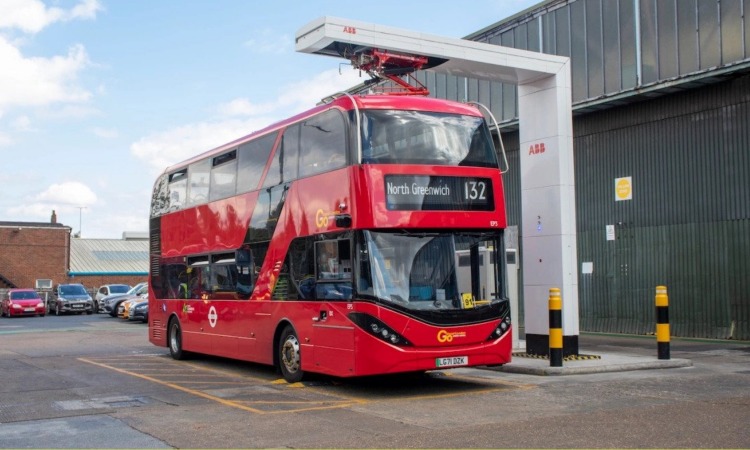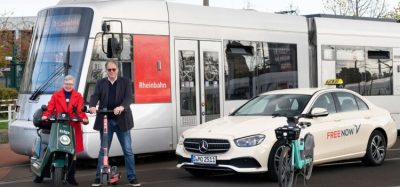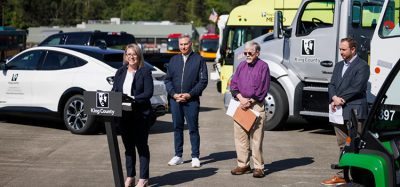TfL introduces new innovative pantograph bus charging technology
- Like
- Digg
- Del
- Tumblr
- VKontakte
- Buffer
- Love This
- Odnoklassniki
- Meneame
- Blogger
- Amazon
- Yahoo Mail
- Gmail
- AOL
- Newsvine
- HackerNews
- Evernote
- MySpace
- Mail.ru
- Viadeo
- Line
- Comments
- Yummly
- SMS
- Viber
- Telegram
- Subscribe
- Skype
- Facebook Messenger
- Kakao
- LiveJournal
- Yammer
- Edgar
- Fintel
- Mix
- Instapaper
- Copy Link
Posted: 28 October 2022 | Intelligent Transport | No comments yet
The new pantograph bus charging technology is being used to rapidly charge the buses on London’s all-electric route 132, providing high-power top-ups multiple times throughout the day for a power boost.


Credit: Transport for London
Transport for London (TfL) has announced that innovative pantograph bus charging technology is now in operation at the Bexleyheath bus garage, providing fast, high-power top-ups.
With the varying length and requirements of London’s bus routes, the introduction of this new technology ensures that infrastructure is in place to support TfL’s zero-emission ambitions. In 2021, TfL launched 20 double decker hydrogen buses on routes 7 and 245, to test longer range technology in the urban environment.
The new technology uses a pantograph, an arm-like structure, that attaches itself to the roof to deliver a quick, high-power charge to buses. Wireless RFID technology is used to allow the bus to communicate with the pantograph. This is the first time this technology has been used in London and is being used to power the all-electric route 132.
The buses, which are conventionally charged overnight, receive a high-power current through the pantograph multiple times throughout the day for a power boost – known as ‘opportunity charging’. Each top-up takes less than 10 minutes, allowing buses to travel further each day. The short top-up time and longer distance each bus can cover means fewer buses are needed to provide the same high level of service, allowing resources to be reinvested into other areas of the network.
From 2022, a further extension of ‘opportunity charging’, with pantographs conveniently located at each end of a bus route, will be trialled in another first for London. The 15-mile route 358 between Crystal Palace and Orpington is one of London’s longest, which is why a standard garage charge alone would not sustain a zero-emission bus the entire day. Due to the length of the route, a pantograph at each end of the route, rather than back at the garage, will mean buses receive a quick boost on the spot. The 358 route will also benefit from new buses that resemble a tram, with enhanced customer features and the latest bus safety features.
The Deputy Mayor for Transport, Seb Dance, said: “The introduction of the pantograph builds on the progress we have already made to run a cleaner and greener bus service. Transforming London’s bus fleet is an important part of the Mayor’s target of getting London to net zero by 2030, and his aim to build a better London – a fairer, greener and more prosperous city for all.”
Louise Cheeseman, TfL’s Director of Bus, said: “When buses can travel further each day, as they do with this exciting pantograph technology, we can deliver the same service that Londoners rely on without increasing the number of buses and invest in other routes. The installation of the rapid pantograph charging for route 132 is a key step to help us get zero-emission buses running on routes all across London.”
If you liked this, you may also be interested in:
▶ TfL to extend London’s e-scooter trial following national trial extensions
▶ Long-term UK government settlement agreed with Transport for London
Related topics
Air Quality, Alternative Power, Fleet Management & Maintenance, Intelligent Transport Systems (ITS)
Related modes
Bus & Coach
Related cities
London
Related countries
United Kingdom
Related organisations
Transport for London (TfL)
Related people
Louise Cheeseman, Seb Dance







